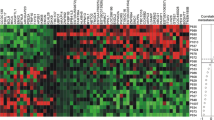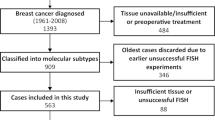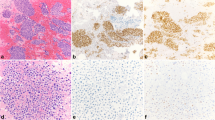Abstract
Lymphatic invasion (LVI) is associated with disease recurrence in axillary node-negative (ANN) breast cancer. Using gene expression profiling of 105 ANN tumors, we found that podocalyxin (PODXL) was more highly expressed in tumors with LVI (LVI+) than in those without LVI (LVI−). Differences in PODXL expression were validated using real-time polymerase chain reaction as well as by immunohistochemistry in an independent set of 652 tumors on tissue microarrays. Disease-free survival (DFS) analyses were conducted for association of high PODXL protein expression with risk of distant recurrence overall and within breast cancer subtypes using both Cox and cure-rate models. High PODXL expression was associated with poor prognosis features including large tumor size, high histological grade, estrogen and progesterone receptor negativity, and with clinical alterations characteristic of the basal-like breast cancer phenotype. Surprisingly, despite having other poor prognosis characteristics, women with high PODXL expressing tumors had better long-term DFS in multivariate analysis with traditional clinicopathologic factors including LVI and HER2 status (P = 0.001). PODXL has the potential to be a useful biomarker for identifying good prognosis patients in characteristically poor prognosis breast cancer groups and may impact treatment of women with this disease.




Similar content being viewed by others
Abbreviations
- ANN:
-
Axillary node-negative
- CK5:
-
Cytokeratin 5
- DFS:
-
Disease-free survival
- EGFR:
-
Epidermal growth factor receptor
- ER:
-
Estrogen receptor
- GEA:
-
Gene expression array
- HER2:
-
Human epidermal growth factor receptor 2
- HR:
-
Hazard ratio
- IHC:
-
Immunohistochemistry
- K–M:
-
Kaplan–Meier
- LVI:
-
Lymphatic invasion
- OR:
-
Odds ratio
- PH:
-
Proportional hazards
- p53:
-
Protein 53
- PODXL:
-
Podocalyxin
- PgR:
-
Progesterone receptor
- RT-PCR:
-
Real-time polymerase chain reaction
- TMA:
-
Tissue microarray
References
Bull SB, Ozcelik H, Pinnaduwage D, Blackstein ME, Sutherland DA, Pritchard KI, Tzontcheva AT, Sidlofsky S, Hanna WM, Qizilbash AH, Tweeddale ME, Fine S et al (2004) The combination of p53 mutation and neu/erbB-2 amplification is associated with poor survival in node-negative breast cancer. J Clin Oncol 22:86–96
Kerjaschki D, Poczewski H, Dekan G, Horvat R, Balzar E, Kraft N, Atkins RC (1986) Identification of a major sialoprotein in the glycocalyx of human visceral glomerular epithelial cells. J Clin Invest 78:1142–1149
Kershaw DB, Beck SG, Wharram BL, Wiggins JE, Goyal M, Thomas PE, Wiggins RC (1997) Molecular cloning and characterization of human podocalyxin-like protein. J Biol Chem 272:15708–15714
Sassetti C, Van Zante A, Rosen SD (2000) Identification of endoglycan, a member of the CD34/podocalyxin family of sialomucins. J Biol Chem 275:9001–9010
McNagny KM, Pettersson I, Rossi F, Flamme I, Shevchenko A, Mann M, Graf T (1997) Thrombomucin, a novel cell surface protein that defines thrombocytes and multipotent hematopoietic progenitors. J Cell Biol 138:1395–1407
Kerosuo L, Juvonen E, Alitalo R, Gylling M, Kerjaschki D, Miettinen A (2004) Podocalyxin in human haematopoietic cells. Br J Haematol 124:809–818
Doyonnas R, Kershaw DB, Duhme C, Merkens H, Chelliah S, Graf T, McNagny KM (2001) Anuria, omphalocele, and perinatal lethality in mice lacking the CD34-related protein podocalyxin. J Exp Med 194:13–27
Takeda T, Go WY, Orlando RA, Farquhar MG (2000) Expression of podocalyxin inhibits cell–cell adhesion and modifies junctional properties in Madin-Darby canine kidney cells. Mol Biol Cell 11:3219–3232
Kerjaschki D, Vernillo AT, Farquhar MG (1985) Reduced sialyation of podocalyxin–the major sialoprotein of the rat kidney glomerulus–in aminonucleoside nephrosis. Am J Path 118:343–349
Pericacho M, Alonso-Martin S, Larrucea S, González-Manchón C, Fernández D, Sanchez I, Ayuso MS, Parrilla R (2011) Diminished thrombogenic responses by deletion of the podocalyxin gene in mouse megakaryocytes. PLoS One 6:e26025
Alonso-Martin S, Nowakowski A, Larrucea S, Fernández D, Vilar-Egla M, Ayuso MS, Parrilla R (2010) Overexpression of podocalyxin in megakaryocytes and platelets decreases the bleeding time and enhances the agonist-induced aggregation of platelets. Thromb Res 125:e300–e305
Larsson A, Johansson ME, Wangefjord S, Gaber A, Nodin B, Kucharzewska P, Welinder C, Belting M, Eberhard J, Johnsson A, Uhlén M, Jirström K (2011) Overexpression of podocalyxin-like protein is an independent factor of poor prognosis in colorectal cancer. Br J Cancer 105:666–672
Somasiri A, Nielsen JS, Makretsov N, McCoy ML, Prentice L, Gilks CB, Chia SK, Gelmon KA, Kershaw DB, Huntsman DG, McNagny KM, Roskelley CD (2004) Overexpression of the anti-adhesin podocalyxin is an independent predictor of breast cancer progression. Cancer Res 64:5068–5073
Dallas MR, Chen SH, Streppel MM, Sharma S, Miatra A, Konstantopoulos K (2012) Sialofucosylated podocalyxin is a functional E- and L-selectin ligand expressed by metastatic pancreatic cancer cells. Am J Physiol 303:C616–C624
Yasuoka H, Tsujimoto M, Inagaki M, Kodama R, Tsuji H, Iwahashi Y, Mabuchi Y, Ino K, Sanke T, Nakamura Y (2012) Clinicopathological significance of podocalyxin and phosphorylated ezrin in uterine endometroid adenocarcinoma. J Clin Pathol 65:399–402
Kelley TW, Huntsman D, McNagny KM, Roskelley CD, Hsi ED (2005) Podocalyxin: a marker of blasts in acute leukemia. Am J Clin Pathol 124:134–142
Heukamp LC, Fischer HP, Schirmacher P, Chen X, Breuhahn K, Nicolay C, Buttner R, Gutgemann I (2006) Podocalyxin-like protein 1 expression in primary hepatic tumours and tumour-like lesions. Histopathology 49:242–247
Naishiro Y, Yamada T, Idogawa M, Honda K, Takada M, Kondo T, Imai K, Hirohashi S (2005) Morphological and transcriptional responses of untransformed intestinal epithelial cells to an oncogenic beta-catenin protein. Oncogene 24:3141–3153
Barton Furness SG, McNagny K (2006) Beyond mere markers: functions for CD34 family of sialomucins in hematopoiesis. Immunol Res 34:13–32
Larrucea S, Butta N, Arias-Salgado EG, Alonso-Martin S, Ayuso MS, Parrilla R (2008) Expression of podocalyxin enhances the adherence, migration, and intercellular communication of cells. Exp Cell Res 314:2004–2015
Sizemore S, Cicek M, Sizemore N, Ng KP, Casey G (2007) Podocalyxin increases the aggressive phenotype of breast and prostate cancer cells in vitro through its interaction with ezrin. Cancer Res 67:6183–6191
Sy JP, Taylor JM (2000) Estimation in a Cox proportional hazards cure model. Biometrics 56:227–236
Andrulis IL, Bull SB, Blackstein ME, Sutherland D, Mak C, Sidlofsky S, Pritzker KP, Hartwick RW, Hanna W, Lickley L, Wilkinson R, Qizilbash A et al (1998) neu/erbB-2 amplification identifies a poor-prognosis group of women with node-negative breast cancer. Toronto Breast Cancer Study Group. J Clin Oncol 16:1340–1349
Mulligan AM, Pinnaduwage D, Bull SB, O’Malley FP, Andrulis IL (2008) Prognostic effect of basal-like breast cancers is time dependent: evidence from tissue microarray studies on a lymph node-negative cohort. Clin Cancer Res 14:4168–4174
McShane LM, Altman DG, Sauerbrei W, Taube SE, Gion M, Clark GM (2005) REporting recommendations for tumour MARKer prognostic studies (REMARK). Br J Cancer 93:387–391
Allred DC, Harvey JM, Berardo M, Clark GM (1998) Prognostic and predictive factors in breast cancer by immunohistochemical analysis. Mod Pathol 11:155–168
Liu CL, Prapong W, Natkunam Y, Alizadeh A, Montgomery K, Gilks CB, van de Rijn M (2002) Software tools for high-throughput analysis and archiving of immunohistochemistry staining data obtained with tissue microarrays. Am J Pathol 161:1557–1565
Cox DR, Oakes D (1984) Analysis of survival data. Chapman and Hall, London
Farewell VT (1982) The use of mixture models for the analysis of survival data with long-term survivors. Biometrics 38:1041–1046
Heinze G, Ploner M (2002) SAS and SPLUS programs to perform Cox regression without convergence problems. Comput Methods Programs Biomed 67:217–223
Nielsen JS, McNagny KM (2009) The role of podocalyxin in health and disease. J Am Soc Nephrol 20:1669–1676
Harvey JM, Clark GM, Osborne CK, Allred DC (1999) Estrogen receptor status by immunohistochemistry is superior to the ligand-binding assay for predicting response to adjuvant endocrine therapy in breast cancer. J Clin Oncol 17:1474–1481
Mohsin SK, Weiss H, Havighurst T, Clark GM, Berardo M, Roanh LD, To TV, Zho Q, Love RR, Allred DC (2004) Progesterone receptor by immunohistochemistry and clinical outcome in breast cancer: a validation study. Mod Pathol 17:1545–1554
O’ Malley FP, Parkes R, Latta E, Tjan S, Zadro T, Mueller R, Arneson N, Blackstein M, Andrulis I (2001) Comparison of HER2/neu status assessed by quantitative polymerase chain reaction and immunohistochemistry. Am J Clin Pathol 115:504–511
Acknowledgments
This study has been supported by a grant from the Canadian Institutes of Health Research and with funds provided by the Terry Fox Run (ILA, SBB, FO’M), by a Senior Investigator award from the Canadian Institutes of Health Research (SBB), and by project funds from the MITACS Network of Centres of Excellence in Mathematical Sciences (SBB). YEY is supported by MITACS Industrial Fellowship and a CIHR Fellow in Genetic Epidemiology and Statistical Genetics with CIHR STAGE (Strategic Training for Advanced Genetic Epidemiology). The authors thank the study participants and gratefully acknowledge the technical assistance of Lucine Bosnoyan-Collins and Suzanne Tjan and the contributions of the Toronto Breast Cancer Group to this work. We also thank Candemir Cigsar for statistical insights.
Conflict of interest
The authors declare they have no conflicts of interest.
Author information
Authors and Affiliations
Corresponding author
Additional information
C. L. Forse and Y. E. Yilmaz contributed equally to this work.
Rights and permissions
About this article
Cite this article
Forse, C.L., Yilmaz, Y.E., Pinnaduwage, D. et al. Elevated expression of podocalyxin is associated with lymphatic invasion, basal-like phenotype, and clinical outcome in axillary lymph node-negative breast cancer. Breast Cancer Res Treat 137, 709–719 (2013). https://doi.org/10.1007/s10549-012-2392-y
Received:
Accepted:
Published:
Issue Date:
DOI: https://doi.org/10.1007/s10549-012-2392-y




